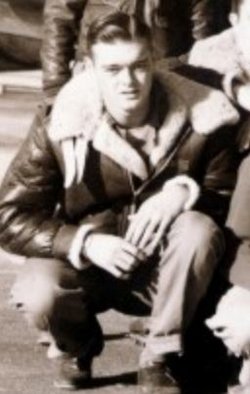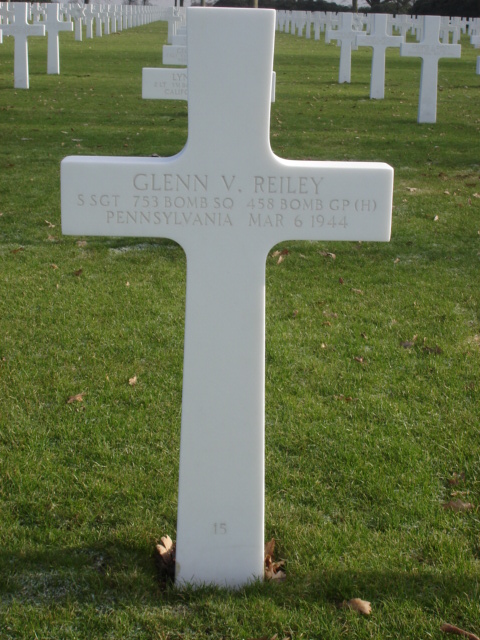Gunner S/Sgt. Glenn V. Reiley KIA
Hometown: Pennsylvania
Squadron: 753rd 458th Bomb Group
Service #13048158
Awards: Purple Heart
Pilot Captain Jack L. Bogusch KIA
MACR # 3346
Target:DAIMLER-BENZ MOTOR WORKS Berlin.
Mission: 6-Mar-44
Serial Number:41-29286
Aircraft Model B-24D
Aircraft Letter:
Aircraft Name:
Location: Tubbergen, Holland
Cause: FLAK and Fighters Crew of 10 4KIA 6POW
Andrew and Crew 35 crew's first combat mission was on March 6, 1944, the first American raid on Berlin. Due to illness, Lloyd Andrew would not make this mission. Also not a part of the crew on this day was bombardier 2Lt George Thompson. Their places were taken by Captain Jack Bogusch, 753rd Operations Officer and 2Lt Robert Swift, bombardier from Crew 22.
The 458th did not meet any German defenses until they were over Berlin. On the bomb run there was a problem with the lead ship and no bombs were dropped. Colonel Isbell, leading the group, decided upon another run and turned the formation around to come in again on the same target. The B-24's of the 458th paid the price on this second run, as five aircraft were downed – the most lost by the group on a single mission.
Crew 35, flying in the lead squadron directly behind the first element, sustained several flak hits, but no major damage. At some point after bombs away FW-190's attacked the formation and the crew lost power on three of their four engines. They dropped out of formation and headed down. The bailout alarm was sounded and the men began to leave.
According to the Missing Air Crew Report (MACR 3346), 2Lt Robert Slencak stated that Captain Jack L. Bogusch, "either elected to crash land and couldn't or he didn't have time to jump." Slencak opened his chute on leaving the plane and hit the ground almost immediately. 2Lt Robert Swift stated that "Captain Bogusch remained at the controls attempting to get the engines started again and failed to leave the controls in sufficient time to jump because the plane was at too low of an altitude." The B-24 crashed in the vicinity of Tubbergen, Holland with Captain Bogusch still in the cockpit.
2Lt John P. Egan, navigator, also delayed his jump until it was too late. According to Slencak, "I believe Lt Egan followed me after and jumped (I vaguely remember seeing someone leaving [from the] opposite side of the bomb bay). I found him lying under the wing of the plane, parachute on but unopened. He probably delayed pulling the ripcord for a second or two [and] in this particular instance it was fatal." Bob Swift last saw Lt Egan, "on the catwalk between the flight deck and nose compartment. Lt Egan did not want me to open the nose wheel doors until the second [alarm] bell was sounded. I chose to slide back to the bomb bay and he followed me. I jumped from the bomb bay with, I should judge, about 8-10 seconds to spare. My parachute opened and I was on the ground. Lt Egan apparently did not have time to jump. I never heard the second bell. I was not with my regular crew the day we were shot down. Lt Egan's crew may have had different signals than I was used to. This may be the reason he did not want me to open the nose wheel doors."
T/Sgt James H. Musa was also last seen on the flight deck at his radio station. According to Bob Slencak, "he absolutely refused to jump". Despite Slencak's efforts to make him bail out, Musa remained aboard the aircraft and was killed in the crash.
Likewise S/Sgt Glen V. Reiley, top turret gunner remained aboard the aircraft and was killed in the crash. According to the MACR, he was in the bomb bay and motioned for Slencak to jump first. Slencak remembered, "his actions indicated that he would not jump until I did." Since Slencak hit the ground almost immediately after his chute opened, it stands to reason that Reiley did not make it out in time.
The six men who parachuted and landed safely were quickly rounded up and spent the rest of the war in German POW camps, the officers to Stalag Luft I and the enlisted men to Stalag Luft IV. The four men killed in the crash were buried at the cemetery in Albergen on March 12, 1944.
41-29286 Crew
Captain Jack L. Bogusch Pilot KIA
Robert J. Slencak Sr. Co Pilot POW
2nd/Lt. John P. Egan Navigator KIA
2nd/Lt. Robert N. Swift Bombardier POW
S/Sgt. James I. Peteete Engineer POW
T/Sgt. James H. Musa Radio Op. KIA
S/Sgt. Ralph W. Sindelar Gunner POW
S/Sgt. Glenn V. Reiley Gunner KIA
S/Sgt. Winfred Robinson Jr. Gunner POW
S/Sgt. James Mckenzie Gunner POW
Gunner S/Sgt. Glenn V. Reiley KIA
Hometown: Pennsylvania
Squadron: 753rd 458th Bomb Group
Service #13048158
Awards: Purple Heart
Pilot Captain Jack L. Bogusch KIA
MACR # 3346
Target:DAIMLER-BENZ MOTOR WORKS Berlin.
Mission: 6-Mar-44
Serial Number:41-29286
Aircraft Model B-24D
Aircraft Letter:
Aircraft Name:
Location: Tubbergen, Holland
Cause: FLAK and Fighters Crew of 10 4KIA 6POW
Andrew and Crew 35 crew's first combat mission was on March 6, 1944, the first American raid on Berlin. Due to illness, Lloyd Andrew would not make this mission. Also not a part of the crew on this day was bombardier 2Lt George Thompson. Their places were taken by Captain Jack Bogusch, 753rd Operations Officer and 2Lt Robert Swift, bombardier from Crew 22.
The 458th did not meet any German defenses until they were over Berlin. On the bomb run there was a problem with the lead ship and no bombs were dropped. Colonel Isbell, leading the group, decided upon another run and turned the formation around to come in again on the same target. The B-24's of the 458th paid the price on this second run, as five aircraft were downed – the most lost by the group on a single mission.
Crew 35, flying in the lead squadron directly behind the first element, sustained several flak hits, but no major damage. At some point after bombs away FW-190's attacked the formation and the crew lost power on three of their four engines. They dropped out of formation and headed down. The bailout alarm was sounded and the men began to leave.
According to the Missing Air Crew Report (MACR 3346), 2Lt Robert Slencak stated that Captain Jack L. Bogusch, "either elected to crash land and couldn't or he didn't have time to jump." Slencak opened his chute on leaving the plane and hit the ground almost immediately. 2Lt Robert Swift stated that "Captain Bogusch remained at the controls attempting to get the engines started again and failed to leave the controls in sufficient time to jump because the plane was at too low of an altitude." The B-24 crashed in the vicinity of Tubbergen, Holland with Captain Bogusch still in the cockpit.
2Lt John P. Egan, navigator, also delayed his jump until it was too late. According to Slencak, "I believe Lt Egan followed me after and jumped (I vaguely remember seeing someone leaving [from the] opposite side of the bomb bay). I found him lying under the wing of the plane, parachute on but unopened. He probably delayed pulling the ripcord for a second or two [and] in this particular instance it was fatal." Bob Swift last saw Lt Egan, "on the catwalk between the flight deck and nose compartment. Lt Egan did not want me to open the nose wheel doors until the second [alarm] bell was sounded. I chose to slide back to the bomb bay and he followed me. I jumped from the bomb bay with, I should judge, about 8-10 seconds to spare. My parachute opened and I was on the ground. Lt Egan apparently did not have time to jump. I never heard the second bell. I was not with my regular crew the day we were shot down. Lt Egan's crew may have had different signals than I was used to. This may be the reason he did not want me to open the nose wheel doors."
T/Sgt James H. Musa was also last seen on the flight deck at his radio station. According to Bob Slencak, "he absolutely refused to jump". Despite Slencak's efforts to make him bail out, Musa remained aboard the aircraft and was killed in the crash.
Likewise S/Sgt Glen V. Reiley, top turret gunner remained aboard the aircraft and was killed in the crash. According to the MACR, he was in the bomb bay and motioned for Slencak to jump first. Slencak remembered, "his actions indicated that he would not jump until I did." Since Slencak hit the ground almost immediately after his chute opened, it stands to reason that Reiley did not make it out in time.
The six men who parachuted and landed safely were quickly rounded up and spent the rest of the war in German POW camps, the officers to Stalag Luft I and the enlisted men to Stalag Luft IV. The four men killed in the crash were buried at the cemetery in Albergen on March 12, 1944.
41-29286 Crew
Captain Jack L. Bogusch Pilot KIA
Robert J. Slencak Sr. Co Pilot POW
2nd/Lt. John P. Egan Navigator KIA
2nd/Lt. Robert N. Swift Bombardier POW
S/Sgt. James I. Peteete Engineer POW
T/Sgt. James H. Musa Radio Op. KIA
S/Sgt. Ralph W. Sindelar Gunner POW
S/Sgt. Glenn V. Reiley Gunner KIA
S/Sgt. Winfred Robinson Jr. Gunner POW
S/Sgt. James Mckenzie Gunner POW
Gravesite Details
Entered the service from Pennsylvania.
Family Members
Sponsored by Ancestry
Advertisement
Records on Ancestry
Advertisement






